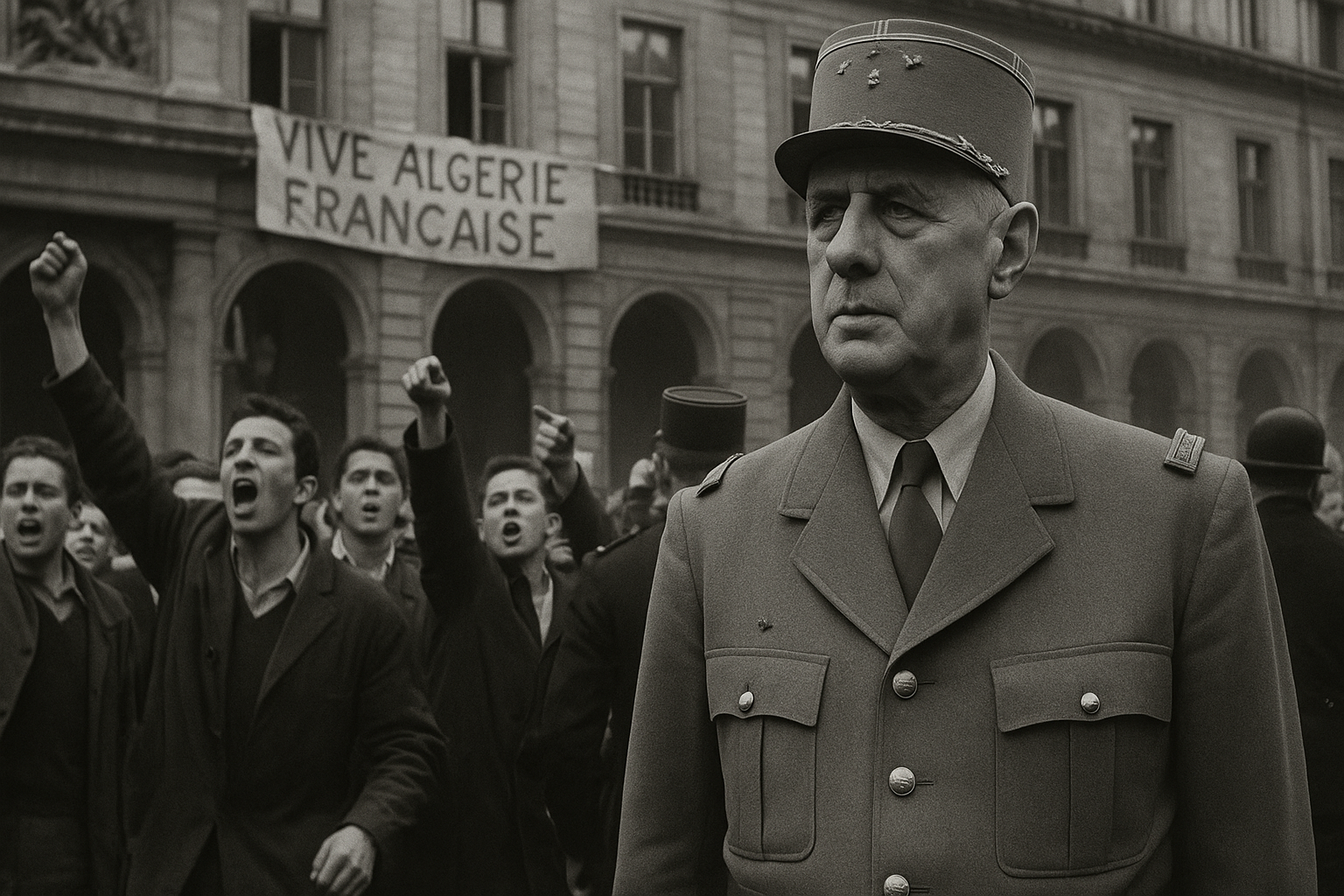Crisis in Algiers, De Gaulle’s Return, and the Fall of the Fourth Republic
When Americans picked up the May 26, 1958 issue of Time Magazine, they weren’t just reading about distant politics. They were witnessing the collapse of France’s Fourth Republic and the dramatic return of Charles de Gaulle, the towering figure of modern French history. This particular issue carried a gripping feature on the chaos in Algeria, the paralysis in Paris, and the political maneuvers that would reshape not just France, but the entire balance of power in postwar Europe.
For readers in the United States, this was more than a story of a government crisis overseas. It was a window into the fragility of democratic institutions in the face of colonial wars and a reminder that Europe’s postwar order was still unsettled. Above all, it was a preview of the man who, once again, was poised to lead France through uncertainty — General Charles de Gaulle.
By the spring of 1958, France was in turmoil. The bitter and bloody war in Algeria had dragged on for nearly four years, draining resources and morale. French settlers in Algiers — backed by sympathetic elements of the army — demanded stronger leadership in Paris and denounced what they saw as the weakness of civilian politicians.
On May 13, 1958, a military-backed insurrection in Algiers toppled the colonial administration and demanded the return of de Gaulle to power. General Jacques Massu, hero of earlier campaigns in Algeria, became the face of the rebellion, insisting that only de Gaulle could save France from collapse.
Meanwhile in Paris, the Fourth Republic’s revolving-door governments had left the country leaderless. The National Assembly had seen 25 different governments in 12 years, each too weak to address the deepening crises. Now, as barricades rose in Algiers and rumors of paratrooper landings in Paris spread, France faced its gravest constitutional breakdown since World War II.
It was against this backdrop that Time Magazine offered American readers its detailed portrait of a nation at the edge — and the return of Charles de Gaulle, the wartime leader who declared: “I am ready.”
By 1958, Time had established itself as one of the most influential weekly newsmagazines in the world. Its editors understood how to weave foreign crises into stories that American readers could understand, drawing sharp portraits of leaders and vivid descriptions of events.
The May 26 issue did exactly that. Rather than presenting abstract policy debates, Time introduced readers to the key players:
-
Charles de Gaulle, the austere general waiting in the wings.
-
Pierre Pflimlin, the “man in the middle,” struggling to hold together a collapsing government.
-
General Jacques Massu, the “rebellious patriot,” whose paratroopers forced the crisis to its climax.
Accompanied by photographs of angry mobs storming the Assembly in Paris, riot police clashing with protesters, and de Gaulle standing resolute, the issue gave American families a direct sense of the stakes. This wasn’t just another government reshuffle in Europe — it was the possible end of French democracy as they knew it.
The cover of the May 26, 1958 issue set the tone with a bold image of Charles de Gaulle, framed in stark black and white. His stern face and military posture reminded readers of wartime — a man who had once defied Nazi occupation and who now might again be France’s savior.
Inside, Time’s editorial style came alive. The magazine’s trademark blend of sharp reporting, character sketches, and dramatic narrative helped readers make sense of a complicated story. Rather than drowning them in parliamentary procedure, it presented the crisis as a human drama — complete with villains, saviors, and uncertain outcomes.
Where newspapers might have listed events dryly, Time gave readers atmosphere: the shouting in the French Assembly, the tension in Algiers, and the whispered rumors of coups. For Americans far removed from French politics, this style made the story urgent, comprehensible, and unforgettable.
-
De Gaulle’s Return – Time emphasized de Gaulle’s readiness to resume leadership, quoting his statement: “I am ready.” His reputation from World War II made him appear as France’s only hope.
-
Pierre Pflimlin’s Struggle – Newly appointed Premier Pflimlin was portrayed as capable but doomed, trapped between the army’s demands and the Assembly’s divisions.
-
Massu’s Defiance – General Jacques Massu, leading the paratroopers in Algiers, was described as the soldier who defied Paris and set the stage for de Gaulle’s return.
-
Street Protests in Paris – Dramatic images showed mobs storming government buildings, symbolizing the fragility of civilian power.
-
The Fall of the Fourth Republic – Time hinted — correctly — that these events would end the unstable postwar regime and inaugurate the Fifth Republic, with de Gaulle at its helm.
Each of these elements combined into a larger narrative: France was collapsing under the weight of colonial war and political division, and only de Gaulle had the authority to restore order.
For collectors of vintage magazines, the May 26, 1958 Time Magazine is more than old newsprint. It is a first draft of history, capturing the exact week when the Fourth Republic gave way to the Fifth.
Why is it so collectible?
-
Historical Timing – This issue appeared just days after the May 1958 insurrection in Algiers, making it one of the earliest American accounts of de Gaulle’s comeback.
-
Iconic Figures – With portraits of de Gaulle, Pflimlin, and Massu, it features three men whose names defined this turning point in French history.
-
Cultural Significance – To own this issue is to hold the same edition that American readers studied over breakfast tables in 1958, wondering if France might fall into civil war.
-
Collector Demand – Issues covering European crises of the 1950s, especially those tied to de Gaulle and the birth of the Fifth Republic, are highly sought after by historians, collectors, and institutions.
When you hold this issue, you are not just flipping through pages. You are touching a moment when the fate of a nation — and Europe’s balance of power — hung in the balance.
The value of this issue isn’t just in its subject. It represents how Time Magazine shaped American understanding of global events during the Cold War.
By mixing analysis with vivid description, by pairing photographs with narrative, Time made distant crises immediate. In an era before 24-hour television news, these weekly issues were how many Americans saw the world.
That is why vintage Time magazines endure today — they are time capsules, holding the urgency and uncertainty of the past exactly as it was felt at the moment.
If you’re fascinated by this pivotal moment in European history, the May 26, 1958 issue of Time Magazine is a must-have. It captures the week when de Gaulle returned, when riots shook Paris, and when France stood at the edge of collapse.
👉 Browse the full collection of original Time magazines here:
Original Time Magazines Collection
Whether you’re a seasoned collector, a history buff, or someone honoring the memory of relatives who lived through the Cold War, these magazines are more than reading material. They are artifacts of history, as relevant today as when they first hit newsstands.
The May 26, 1958 issue of Time Magazine remains one of the most significant Cold War-era publications. Its coverage of France’s collapse in Algeria, the paralysis of the Fourth Republic, and the dramatic return of Charles de Gaulle offered American readers both clarity and urgency.
Holding this issue today is holding the exact moment when France shifted course, when democracy faltered, and when a general once again became the face of the nation. Thanks to Time’s sharp reporting and unforgettable imagery, those events are preserved — ready for us to study, collect, and remember.
For anyone who values history, vintage Time magazines are not simply paper — they are living history.

